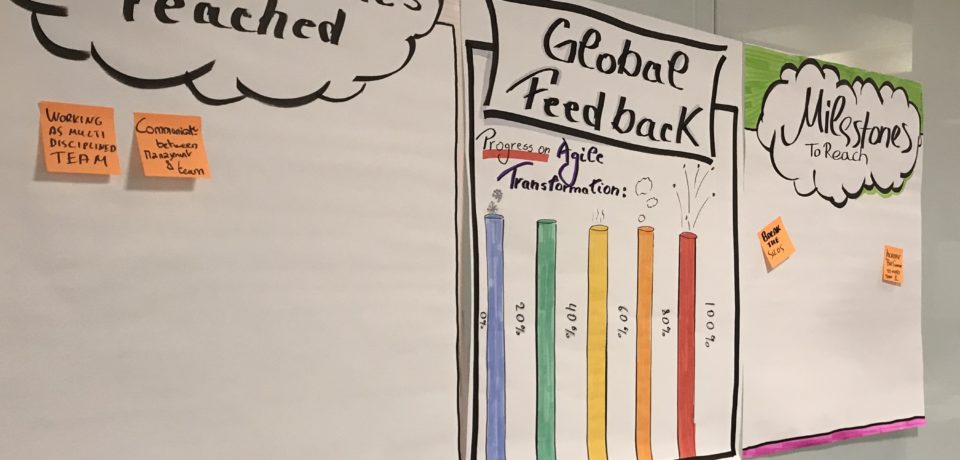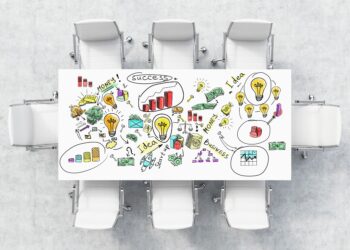Wemanity Luxembourg facilitated a global at scale retrospective, which span an entire day, for one of its clients. It was a great day that raised awareness among people on existing good practices and that encouraged them to also commit to a new set of improvement actions.
Everyone who has already prepared large-scale workshops or retrospectives – in our case, 70 participants – might have an idea of their complexity in terms of organisation, agenda and value provided. It requests alignment, focus, creativity and especially desire to provide something productive and memorable as well. So how did we do it?
How did we do it?
First of all, we started preparations for the MVP Global Retrospective about one month earlier within the facilitators’ team of six (Wemanity Luxembourg and client), by defining our goal and aligning on the retrospective objectives in order to ensure that there will be no time wasting for both attendees (company included) and facilitators. When we start planning an event like this one, creativity runs free and we need to keep focus on the agreed objectives, so a constant practice is challenging all propositions in order to ensure that we do not deviate and we provide the expected value.
Our role is to facilitate Agile Transformations and we worked as an Agile team for the preparation as well. In terms of visualization, we had our own visual board with tasks to complete against the agenda, best activities to suggest, team construction strategies, activities inputs and outputs, area mapping, visual facilitation and so on. The question that arose each time we started working on something was: what will be the value provided to the participants and for the transformation?
After a few brainstorming sessions, we came to an agreement on the agenda and on the retrospective streams and workshop axis. The latter therefore became: Team Stream with Teamwork and Collaboration axes, Vertical Stream with Delegation and Root Cause Analysis axes and Community Stream with Product Owner and DevOps axes. Focus on these has been our main goal on what we considered to be a memorable retrospective day.
Approach of the retrospective
Following the six axes, we have divided the workspace into 6 different workshop areas, each identified by its own colour code. We have also provided a floor colour map for the attendees to consult.
The prerequisites of the retrospective were that 1) every participant must attend all six workshops during the retrospective day; and 2) each group attending a workshop at one time must comprise at most one manager. The purpose of this setup was to give the attendees the opportunity to organize, encouraging freedom of choice and engagement in taking decisions as well as a casual atmosphere. We have chosen this approach as it is the way you set up the environment that represents the way practices grow within. This allowed further crystallization of the already known (and practiced) Agile principles the teams use in their daily activities. They also had the opportunity to interact with colleagues from different teams/departments, highly contributing to raising awareness of dependencies.
Approaching the workshops in an iterative manner (the same workshop was hosted by the same facilitator six times during the retrospective day) allowed the team of facilitators to gather feedback and identify viable improvement actions which were then translated into a better execution over each run. This approach gave us a statistical advantage of reducing the randomness and impact of the influence of strong personalities.
In terms of content we focused on the following exercises for each axis: Teamwork axis with 5 Squares Game, Collaboration axis with Connected Drawings and Change Priorities Game, Delegation axis with Delegation Poker, Root Cause Analysis axis with Fishbone Diagram and 5 Whys, Product Owner axis with Build a space with straws and DevOps axis with Kapla Game. These exercises have been chosen in order to accommodate the needs of the organization and they are the result of multiple discussions inside the Facilitators Team, having as well been put to the test amongst. The business value of each, as well as the personalized input, has been subject to extensive analysis.
Teamwork
Via the 5 Squares Game (Broken Squares – Dr. Alex Bavelas, 1973) we tried to focus on proving the negative effects of working in silos. It also served as a starting point for learning the benefits of real teamwork and of leaning towards the collective success rather than sticking to one’s comfort zone. During the workshops, we have observed the fact that there is always a trigger that pushes a team towards collaboration. We believe that it is important, as facilitators, to work towards minimizing the time it takes each team to reach this trigger. This, consecutively, increases productivity and transparency.
Collaboration
The Connected Drawings exercise focused on the benefits of Agile. The rules are quite simple: each participant receives a post-it on which he has to do a part of a drawing that put alongside the rest of the post-its in a pre-established order, gives a complete drawing. Teams went, during the workshop, through both an Agile and Waterfall approach. They were thus able to observe the increased efficacy of tasks parallelization. Collaboration in early stages and feature breakdown were also part of this exercise as teams debated prior to working. The most important aspect observed by the facilitator was the desire to clarify requirements and to align on each task in order to have a unified Vision of the “product”. The participants proved excellent collaboration skills and high willingness to self-organize.
The Change Priorities exercise was aimed to reinforce the concept of trust and, of course, collaboration. There are two dimensions of trust that the facilitator tried to outline: 1) trust the Business, they are your users and they know what they want and 2) trust your team, they are your colleagues and they know how to get things done. Throughout the day, a high level of team trust was observed; therefore, it wasn’t a surprise to learn that the participants were not afraid of letting the team guide them.
Delegation
Delegation Poker (Management 3.0 – Jurgen Appelo) focused on context adapted subjects that were offered to participants for discussion which then led towards delegation voting. The purpose was to facilitate an unbiased and rational delegation discussion, thus clarifying on who’s responsible for what and to what level. This discussion should be driven by the following seven levels of delegation: tell, sell, consult, agree, advise, inquire, delegate. The exercise also proves that team members should always be fully aware of the capabilities inside the team and, most importantly, trust their teammates.
Root Cause Analysis
Root Cause Analysis with Fishbone and 5 Whys also offered the participants a list of subjects for discussion, only this time the debate was focused on asking why. The facilitator used this method to enable teams to find the real causes of various problems. The exercise also encouraged teams to dig deeper using an objective approach and discover the real “why” and decide on and offer action points. Another purpose of this workshop was to facilitate the identification of recurring problems in order to prevent them from happening again. This workshop is used in the Inspect of Adapt in the SAFe framework.
Product Ownership
Build a space with straws expertise was created to support the PO role, but also to bring the importance of proactivity from the team. Following a set of suggestions on different facilities, such as an airport, a construction site, a port, and groups’ selection, the participants committed to building one of these during four sprints. Straws, post-its, markers, scotch tape were provided as “building” materials. During the first sprint, the PO only provides the team with the type of facility requested: I need an airport. In the second sprint, the team can ask questions, but the PO can only answer “yes” or “no”. During the third sprint, the PO can explain clearly two items from the backlog but management interruption is introduced in the middle of the sprint. Open communication/collaboration is encouraged for the fourth sprint. All items on the list had score points assigned, a total of 150 to reach if all requirements were complete. At the end we could compare and tell the group of their achievement, allowing them also to understand the concept value of backlog items. The facilitator aimed to raise awareness in teams about Product Backlog, ceremonies and roles’ importance.
DevOps
DevOps axis presented Kapla, a wooden construction game made up of a set of identical blocks whose concept is user-friendly. The aim of this game was to highlight five essential concepts from a DevOps perspective: stop starting, start finishing/have a WIP limit; silos break any collaboration effort; in silos, contradictive objectives are not visible, collaboration makes it easier to deliver; automation enables very fast deployment. The teams thus understood that collaboration, even between departments is essential for reaching milestones and delivering on time.
Different energizers and icebreakers were scattered between workshops in order to maintain a high engagement level and to facilitate networking opportunities.
Each workshop ended with dedicated time for reflection on best practices and improvement actions. Each attendee was asked to identify these in his day to day team engagement, team dependencies, and ongoing Agile Transformation. The results were then summarized and presented during the final part of the retrospective mainly by participants who volunteered for it.
During the whole retrospective day, we made available for the participants a series of self-service evaluation and milestones to reach posters on their ongoing Agile Transformation.
In order to prepare the retrospective, we have made extensive use of visual facilitation to make this an even more memorable day. Visual facilitation served as a friendlier way to describe the workshop exercises and their rules as well as the agenda and the guidelines of the day. It also proved out to be a more effective way of collecting feedback, challenging status quo and sparking discussions.
One important element of innovation was the agenda of the day. We focused on giving visual hints instead of explicitly naming the agenda entries. We believe this type of rather light-hearted presentation appeals to the eye and stirs curiosity.
Conclusion
The team of facilitators from Wemanity Luxembourg has used the feedback received during the retrospective to sketch up an Improvement & Benefits plan on different organizational levels.
However, as facilitators promoting the Agile way of working, we are bound to apply the principles ourselves. The retrospective has been a rich experience for us too, so we had a quick gathering to discuss what worked well, what didn’t, and we took corrective actions for the next events.
Want to learn more about at scale transformations ? Read this article.












